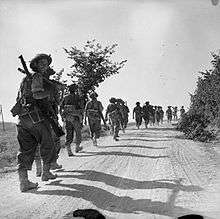128th Infantry Brigade (United Kingdom)
The 128th Infantry Brigade was an infantry brigade of the British Army. The brigade, known as the Hampshire Brigade, served in British India during the First World War but not as a complete formation. During the Second World War the 128th Infantry Brigade fought in the final stages of the North African Campaign in late in Tunisia and the Italian Campaign, and later in the Greek Civil War. Throughout its existence the brigade was composed almost entirely of battalions of the Hampshire Regiment (later Royal Hampshire Regiment).
| Hampshire Brigade 128th (Hampshire) Brigade 128th Infantry Brigade | |
|---|---|
 Formation patch of the 46th Infantry Division. | |
| Active | 1908–1919 1920–1946 1947-? |
| Country | |
| Branch | |
| Type | Infantry |
| Size | Brigade |
| Part of | 43rd (Wessex) Infantry Division 46th Infantry Division |
| Nickname(s) | "The Hampshire Brigade" |
| Engagements | First World War Second World War |
| Commanders | |
| Notable commanders | Frederick Browning Manley Angell James Douglas Kendrew |
History
Formation
The Hampshire Brigade was originally formed on 1 April 1908, when the Territorial Force was created by the amalgamation of the Volunteer Force and the Yeomanry. The brigade was attached to the Wessex Division and was composed of four battalions of the Hampshire Regiment, the 4th (Winchester), 5th (Southampton), 6th (Portsmouth) and 7th (Bournemouth).
First World War
The Wessex Division was mobilised in early August 1914 and was sent overseas to British India in September to free up Regular Army troops for service on the Western Front in France and Belgium. In May 1915 the division was numbered as 43rd (Wessex) Division[1] and the brigade was also numbered, becoming 128th (1st Hampshire) Brigade and the battalions became '1/4th Hampshires', for example, to differentiate them from their 2nd Line duplicates, the 134th (2/1st Hampshire) Brigade of the 45th (2nd Wessex) Division. However, the division, and the brigade, never saw action as a complete unit and was disbanded later in the war. Some of its component units did see active service in the Mesopotamian campaign.[2]
First World War order of battle
- 1/4th Battalion, Hampshire Regiment (left March 1915)
- 1/5th Battalion, Hampshire Regiment
- 1/6th Battalion, Hampshire Regiment (left September 1917)
- 1/7th Battalion, Hampshire Regiment (left January 1918)[1]
Between the wars
The Territorial Force was disbanded shortly after the war ended but reformed in the 1920s as the Territorial Army. The brigade was reformed in the Territorial Army, as the 128th (Hampshire) Infantry Brigade, in 1920 and was again part of the 43rd Division and again included four battalions of the Hampshire Regiment.[3]
However, the composition of the brigade changed over the years. The 5th and 7th battalions were merged in 1923 to become the 5th/7th Battalion, Hampshire Regiment [4] They were replaced in the brigade by the 8th (Isle of Wight Rifles) Battalion, Hampshire Regiment.
In 1937 the 8th (Isle of Wight Rifles) Battalion was converted to the Royal Artillery role as The Princess Beatrice's (Isle of Wight Rifles) Heavy Regiment.[5] The following year, in 1938, all infantry brigades of the British Army were reduced from four infantry battalions to three. As a consequence of this, the 6th (Duke of Connaught's Own) Battalion, Hampshire Regiment was, like the 8th Battalion, transferred to the Royal Artillery and redesignated the 59th (Duke of Connaught's Own) Anti-Tank Regiment, Royal Artillery[6] and became the anti-tank regiment for the 43rd Division. They were replaced in the brigade by the 4th Battalion, Dorset Regiment, originally from the 129th (South Western) Infantry Brigade. The brigade, shortly afterwards, was redesignated the 128th Infantry Brigade.
In the spring and summer of 1939 the Territorial Army was doubled in size and all units were ordered to form a duplicate unit and the 4th Battalion was split in two, to create the 1/4th and 2/4th battalions[7] and 5th/7th Battalion was split into the 5th and 7th battalions.[8] However, unlike, most Territorial divisions which formed an exact 'mirror' duplicate of 2nd Line units, the 43rd (Wessex) was instead split on a geographical basis. The units from Dorset, Wiltshire and Hampshire remained with the 43rd Division and units from Devonshire, Somerset and Cornwall joined the 45th Infantry Division. Therefore, the newly raised 7th Hampshire Regiment and the 4th Dorset Regiment were both transferred to the 130th Infantry Brigade. The 128th Brigade kept the 1/4th and 5th Hampshires, two 1st Line units, and the 2/4th Battalion, a 2nd Line unit.
Second World War
During the Second World War the 128th Brigade was mobilised in September 1939, soon after the outbreak of war. The brigade continued to serve with the 43rd Division and was preparing to go overseas to the Franco-Belgian border to join the British Expeditionary Force (BEF). The brigade was at the time commanded by Brigadier Frederick Browning, a Regular Army officer of the Grenadier Guards. However, the BEF's retreat and evacuation from Dunkirk during the Battle of France cancelled these plans and the division instead remained in Kent on the defensive and prepared for a potential German invasion of England.

On 6 June 1942 the 43rd (Wessex) Division was reorganised as a 'Mixed Division' and 34th Tank Brigade arrived to replace the 128th Infantry. The brigade was, therefore, transferred to the 46th Infantry Division on 15 August, and would remain with the division for the rest of the war. The 128th Brigade remained with the 46th for the rest of the war. With this division the brigade served in Operation Torch, the Allied invasion of North Africa in particular bearing the brunt of the German offensive in Northern Tunisia during Operation Ochsenkopf in the Spring of 1943. After the Axis surrender in May 1943 it then went on to fight in the Italian Campaign from September 1943 until late 1944, when it was sent to Greece to help calm the Greek Civil War.
The 128th Infantry Brigade fought in many battles in Italy including the Salerno landings in September 1943, Naples and at the Gothic Line. It ended the war in Austria. With the 46th Division, it came under command of both the armies fighting in Italy, the U.S. Fifth Army and the British Eighth Army.
Second World War order of Battle
128 Brigade had the following composition during the war:[9]
- 1/4th Battalion, Hampshire Regiment
- 5th Battalion, Hampshire Regiment
- 2/4th Battalion, Hampshire Regiment (until 9 May 1943)
- 128th Infantry Brigade Anti-Tank Company (formed 19 May 1940, disbanded 20 December 1941)
- 2nd Battalion, Hampshire Regiment (from 10 May 1943)[10]
Second World War commanders
The following officers commanded 128th Brigade during the war:[9]
- Brigadier E.D.H. Tollemache (until 31 October 1939)
- Brigadier C.H. Woodhouse (from 31 October 1939 until 19 April 1940)
- Lieutenant Colonel A.L. Scaife (Acting, from 19 to 28 April 1940)
- Brigadier R.F.H. Massy-Westrop (from 28 April until 14 May 1940)
- Brigadier F.A.M Browning (from 14 May 1940 until 20 February 1941)
- Brigadier M.A. James VC (from 20 February 1941 until 21 May 1943)
- Lieutenant Colonel H.C.C. Newnham (Acting, from 21 May until 10 June 1943)
- Brigadier M.A. James VC (from 10 June until 20 September 1943)
- Brigadier J.L. Spencer (from 20 September until 5 November 1943)
- Lieutenant Colonel R. Chandler (Acting, from 5 to 14 November 1943)
- Brigadier T.P.D. Scott (from 14 November 1943 until 24 January 1944)
- Brigadier D.A. Kendrew (from 24 January until 8 December 1944)
- Lieutenant Colonel J.H.H. Robinson (Acting, from 8 December 1944 until 28 January 1945)
- Brigadier D.A. Kendrew (from 28 January 1945)
Post-Second World War
Disbanded after the war, the brigade was reformed in 1947 in the post-war Territorial Army, and saw the merger of the 1/4th and 2/4th battalions to create once again the 4th Battalion, Hampshire Regiment.[7]
The brigade appears to have been finally disbanded in the 1960s.
Victoria Cross recipients
- Captain Richard Wakeford, 2/4th Battalion, Hampshire Regiment, Second World War
- Lieutenant Gerard Ross Norton, 1/4th Battalion, Hampshire Regiment, Second World War
See also
References
- "Home - The Long, Long Trail". 1914-1918.net. Retrieved 30 May 2020.
- "Home - The Long, Long Trail". 1914-1918.net. Retrieved 30 May 2020.
- "43 Division" (PDF).
- "Volunteers, Militia Territorial Formations of the Hampshire Regiment". 1rhamps.com. Retrieved 30 May 2020.
- "Princess Beatrice's Isle of Wight Rifles [UK]". Archived from the original on 30 December 2005. Retrieved 30 May 2020.
- "6th Battalion, The Royal Hampshire Regiment [UK]". Archived from the original on 30 December 2005. Retrieved 30 May 2020.
- "4th Battalion, The Royal Hampshire Regiment [UK]". Archived from the original on 30 December 2005. Retrieved 30 May 2020.
- "5th Battalion, The Royal Hampshire Regiment [UK]". Archived from the original on 30 December 2005. Retrieved 30 May 2020.
- Orders of Battle Second World War 1939-45, H.F. Joslen
- "Archived copy" (PDF). Archived from the original (PDF) on 3 March 2016. Retrieved 31 May 2015.CS1 maint: archived copy as title (link)
Bibliography
- Lt-Col H.F. Joslen, Orders of Battle, United Kingdom and Colonial Formations and Units in the Second World War, 1939–1945, London: HM Stationery Office, 1960/Uckfield: Naval & Military, 2003, ISBN 1-84342-474-6.
External links
- "128 Infantry Brigade". Orders of Battle.com.